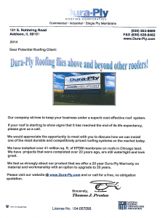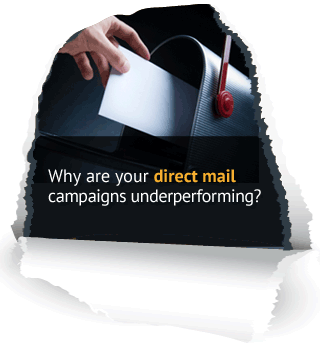

J&C Blog
Find all the latest marketing trends on the J&C Blog.

Find all the latest marketing trends on the J&C Blog.

In the first part of this blog post, I mentioned a direct mail package from a roofing services company that I received many times before, but never opened. I described how I look at the outer envelope for clues, details and “tells” about what may be inside.
In the second part of this blog post, I addressed the look and feel of what was inside the outer envelope of this lead generation direct mail effort. I spoke about the company’s tagline and the look and feel of the letter and headline. Plus, I discussed a helicopter element used without explanation in the letter. I worried that at best this element interrupted the flow of the letter, and worse, might actually depress response.
 In this third installment, I will address the copy in the letter of this direct mail package, and will offer some recommendations for doing B2B lead generation in today’s marketplace.
In this third installment, I will address the copy in the letter of this direct mail package, and will offer some recommendations for doing B2B lead generation in today’s marketplace.
The heart of any letter is the body copy. I have well proven opinions about how direct mail letters should be written. Direct response writers have copywriting skills that should be emulated by writers of any stripe today, because the same techniques apply to email and digital copy. I didn’t say that writers can lift copy from an organization’s website for their direct mail efforts. The content can be the same, but the voice, pacing and structure for each channel are unique and must be appropriate.
 Letter copy needs to be personal, earnest, helpful and persuasive. Headlines and body copy need to get right to the point of a prospect’s needs. Customer focused calls to action are essential in getting prospects to respond. Response is a form of behavior, and writers need to understand a prospect’s decision process to get the most from that behavior.
Letter copy needs to be personal, earnest, helpful and persuasive. Headlines and body copy need to get right to the point of a prospect’s needs. Customer focused calls to action are essential in getting prospects to respond. Response is a form of behavior, and writers need to understand a prospect’s decision process to get the most from that behavior.
Passing the Wee-Wee Test?
In my first agency job, the creative director used to look at copy and say, “It does not pass the Wee-Wee Test.” The first time I heard this I said, “Huh? Wee-Wee Test?” No, the creative director corrected me. It was the We-We Test. What the creative director then said are words that I have never forgotten. He explained that the copy needs to be relevant to the reader and not talk about the brand or product. So, if a line of copy starts out with ‘We,’ then it can’t be talking about benefits to the reader. It has to be talking about the brand or product. It’s the easiest way to lose the reader’s interest, and it will certainly depress response in a direct mail package, email or any copy.
So, how does the copy in this letter match up? The first line in the lead paragraph is, “Our company strives …”; third sentence, “We would appreciate …”; fourth sentence, “We have installed …”; fifth sentence, “We have projects …”; sixth sentence, “We feel so strongly …” Only two sentences in this letter address the reader. The others? Well, they don’t pass the We-We Test. They won’t engage a reader’s attention. A typical prospect, even a qualified prospect, will see the Wes and stop reading.
In great direct mail letters, there are many kinds of copy, none of which exist in this letter. There is no narrative in the copy for the reader to project themselves into. There is no benefit copy for the reader to engage with, capture their attention, act upon or respond to. There is no support copy to help the reader believe any claims made in the letter. There is no sweetener copy to help provide more reasons for readers to respond. And, there is no facilitating copy, copy that helps readers relieve their natural anxiety, making it easier for them to respond.
Don’t make the prospect decide why they purchase from you. Give them the benefits!
This letter, like many others I have read, leaves it up to the reader to decide what’s important to them and why they should respond. The letter does not help them make this decision. People respond to direct mail packages to gain something they didn’t have before or to avoid losing something that they now have. It’s up to marketers to give readers the answers to those questions, even in lead generation mailings.
What else could this letter do better? Maybe a strong offer to reduce customer resistance to responding. Maybe a P.S. at the end to repeat the offer. Maybe include benefits that provide relevance to engage and capture the reader’s attention. Of course, one important question remains. Is one-shot direct mail the best way to do lead generation in the B2B marketplace?
A framework for 21st century B2B lead generation.
If I were taking over his program today, I would likely recommend a different, more contemporary approach. One with both outbound and inbound marketing components. So, the outbound program might include direct mail, but ask qualified prospects to raise their hands, give up a little information and then receive an ever-more relevant series of nurturing letters. I might also include an inbound content marketing component, followed up with a series of nurturing emails, so that the marketer would be in front of the customer when they were ready to make a purchase decision.
This is the way that we do B2B and B2C lead generation programs today, mixing direct mail and email, personalizing, learning more about prospects’ interests over time as they click onto nurturing emails and download additional content. When you create a multichannel marketing communications program where multiple channels are integrated and used together, they simply all work better. In a generation program that includes content marketing, direct mail and email, marketers get significantly better results than when they use any of these channels alone.
This is what we mean when we say that marketers need to be with prospects on their customer journeys. It’s providing multiple ways for prospects to get more information as they move from information seekers to the moment of truth when they are ready to make a purchase. This approach is still dependent on using the tools and techniques of direct marketing, just in a different way. When these tools are ignored, poorly used or misused, marketers are sure to fail or at least waste their money.
 Are you confident your direct mail is being optimized for best practices? Direct mail is one of the leading tactics used by marketers, but many of them aren’t optimizing direct mail efforts to their fullest potential. Sign up for J&C’s personalized webinar, Optimizing Your Direct Mail for Maximum Response, to ensure you are leveraging the most effective direct mail best practices that increase response and drive customer action.
Are you confident your direct mail is being optimized for best practices? Direct mail is one of the leading tactics used by marketers, but many of them aren’t optimizing direct mail efforts to their fullest potential. Sign up for J&C’s personalized webinar, Optimizing Your Direct Mail for Maximum Response, to ensure you are leveraging the most effective direct mail best practices that increase response and drive customer action.
303 E Wacker Drive, Suite 2030
Chicago, IL 60601
Phone: 312-894-3000
Fax: 312-894-3005